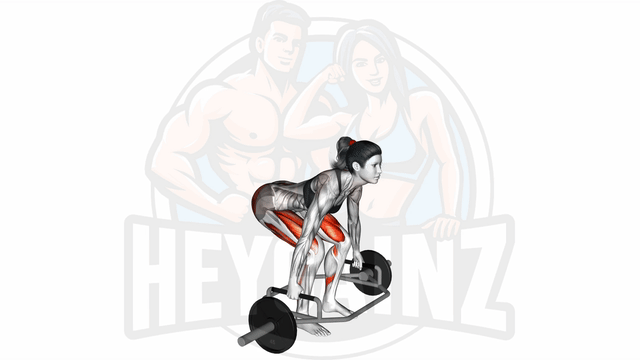
Instructions:
- 1Stand inside the trap bar with your feet shoulder-width apart
- 2Squat down and grasp the handles of the bar
- 3Keep your back straight and lift the weight by pushing through your heels until your legs are fully extended
- 4Pause for a moment and then slowly lower the bar back to the floor
- 5Repeat the movement for the desired number of repetitions
Tips:
- Try to maintain a neutral spine throughout the exercise
- Keep your head in line with your spine
- Engage your core to help with balance and stability
- Control the weight on the way down to avoid injury
Understanding the Trap Bar Deadlift
The trap bar deadlift is an excellent exercise for strengthening the thighs, glutes, and overall posterior chain. This unique form of deadlift utilizes a specialized piece of equipment known as a trap bar, which allows for a more natural lifting position compared to the conventional deadlift. While commonly associated with strength training, the trap bar deadlift can be an effective choice for individuals looking to enhance their fitness, regardless of gender.
Muscles Worked
Engaging multiple muscle groups, the trap bar deadlift primarily targets the thighs and glutes. Additionally, it activates the lower back, hamstrings, and core, making it a highly efficient exercise in a well-rounded fitness routine.
Form and Technique
When performing the trap bar deadlift, proper form is essential to prevent injury and maximize gains. Start by standing in the center of the trap bar, feet shoulder-width apart. Bend at the hips and knees to grasp the handles. Keep your back straight, chest up, and core engaged as you push through your heels to lift the bar. Remember to keep the bar close to your body throughout the movement.
Benefits of the Trap Bar Deadlift
The trap bar deadlift offers several advantages over other exercises. It provides a safer lifting position, reducing the strain on the lower back compared to traditional deadlifts. It is also an excellent alternative for those seeking to build strength without the need for heavy loads, making it suitable for beginners or those focusing on form and technique.
Trap Bar Deadlift vs. Conventional Deadlift
In the debate of trap bar deadlift vs conventional deadlift, many prefer the trap bar version due to its user-friendly design and ability to promote a more upright posture. This can be particularly beneficial for individuals with lower back discomfort or those recovering from injuries.
Standards and Max Calculator
Understanding trap bar deadlift standards can help set realistic goals for your fitness journey. Utilizing a trap bar deadlift max calculator can also aid in determining your ideal lifting capacity based on your current fitness level and goals.
Conclusion
Whether you’re considering incorporating the trap bar deadlift into your workout routine or searching for a trap bar deadlift alternative, it stands out as a versatile and beneficial exercise. With its emphasis on proper form, safety, and engagement of multiple muscle groups, the trap bar deadlift is a valuable addition to any fitness program.